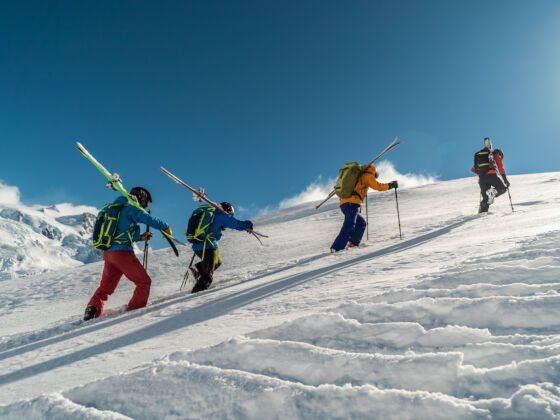THREE FEET DEEP AND FIFTY FEET WIDE, thousands of pounds of snow move at eighty miles per hour. Backcountry skiing can be a dangerous sport. With good partners, a working knowledge of avalanches, and the right equipment, your chances of getting caught in a slide can be significantly reduced. Here’s an x-ray view of what should be in your pack.

Education
The most important tool you can have in the backcountry is good avalanche education (and it takes up zero room in your pack). Whether it’s a one-night course learning the basics or a longer course ending in certification, it’s important to know what you’re up against and how to make educated decisions on what slopes to ski and rescue situations. Check out Avalanche.org for information on locating courses in your area.
Poles
No matter what poles you use, make sure the baskets are big enough for deep snow. I’ve only used alpine poles but adjustable poles are available. Black Diamond’s Flicklock adjustment means your poles will never accidentally collapse.
Climbing Skins
To go down, first you must go up. Skins are used to reach the top of the slope. They come in mohair, which is lighter and better suited for long tours, or nylon, which has better traction for the steeps. Some companies, like G3, make a mohair/nylon blend. A clip on the tail prevents skins from peeling off the ski when they’re icy.
Avalanche Transceiver (also called beacons)
Statistics show an avalanche victim has a 93% chance of being found alive if they are dug out within fifteen minutes. After that, chances of survival drops dramatically. Practice using the transceiver often. Everyone in the group should wear their transceiver inside a layer of clothing so it stays with you in the event of an avalanche. I’ve been using Pieps since before they went digital and highly recommend them.
Probe
Not only are probes helpful for finding members of your own party who may be buried in an avalanche, they can also be used to aid in a probe line. Ski poles that turn into probes can take too much time to set up. Stick with a dedicated probe that’s at least six feet in length.
Shovel
After locating a victim with transceiver and probe you’ll need to dig them out. When an avalanche stops, the snow sets up like concrete. Digging a victim out with your hands is nearly impossible. A metal shovel that packs down easily to fit in your pack but also extends to a comfortable length is critical.
Snow Study Kit
Avalanche safety nerds unite around snow pits. A good snow study kit will include a thermometer, slope meter, snow crystal card, and a magnifying loupe to help analyze the snowpack for weak layers. Mine is quite old but if I were to buy a new one it would be this.
A foldable ruler and notebook are helpful in remembering snow pit statistics you’ve gathered throughout the season, especially if you want to return to the same areas often.
Snow Saw
This handy little tool can be used to dig pits and cut cornices (not recommended unless you have training). Many times they’re made to attach to ski poles or shovel handles. My favorite is the G3 Bonesaw, which also has a ruler to go along with the snow study kit.
Food and Water
So many calories are burned trudging through the backcountry that it’s important to keep eating and drinking. Doing so on regular intervals will help keep you hydrated, fight off chances of hypothermia, and prevent muscles from cramping. I stop every forty-five minutes to an hour even if I don’t feel hungry or thirsty to spend a couple minutes refueling.
Down Jacket
Coldness creeps in quickly when stopping to dig a snow pit, eat lunch, or take a break at the top. A down jacket is nice to throw on over whatever you’re already wearing to keep your core temperature from dropping too low.
Chapstick, Sunscreen, Medical Kit, Compass, Repair Kit, Cell Phone, etc.
There are a multitude of additional items you could carry. I don’t bring most of these (chapstick being the exception) but use your best judgment on what you think will keep you safe.
Backpack
Now put it all in a quality backcountry ski pack. It should be comfortable, carry all your gear, and have straps to attach the skis to the outside. If the pack doesn’t have a dedicated shovel/probe pocket make sure to pack them so they’re easily accessible in case of a burial.
It all comes down to this: know avalanches and backcountry travel, carry the right equipment, travel with a partner(s), and don’t be afraid to turn around and come home if conditions aren’t right. Live to ride another day.